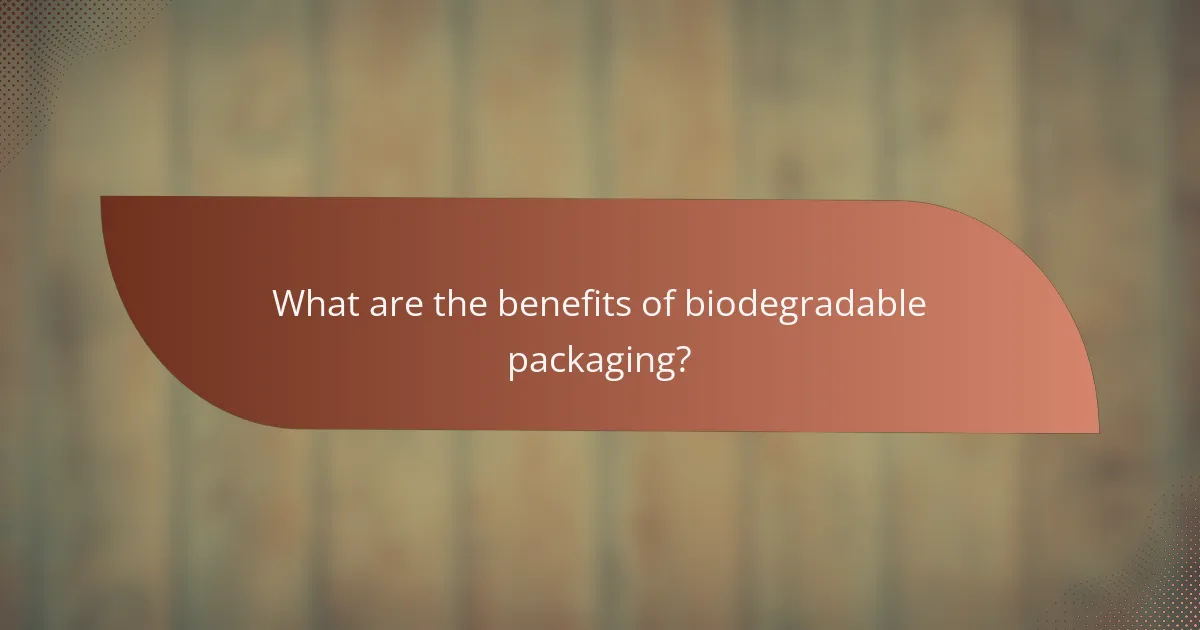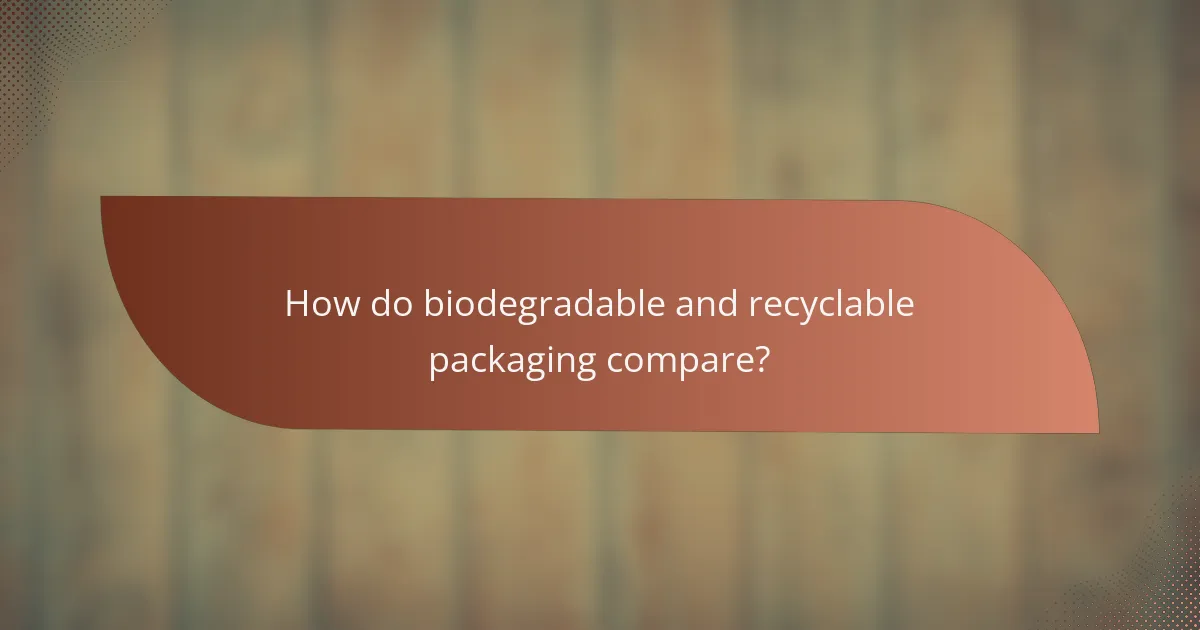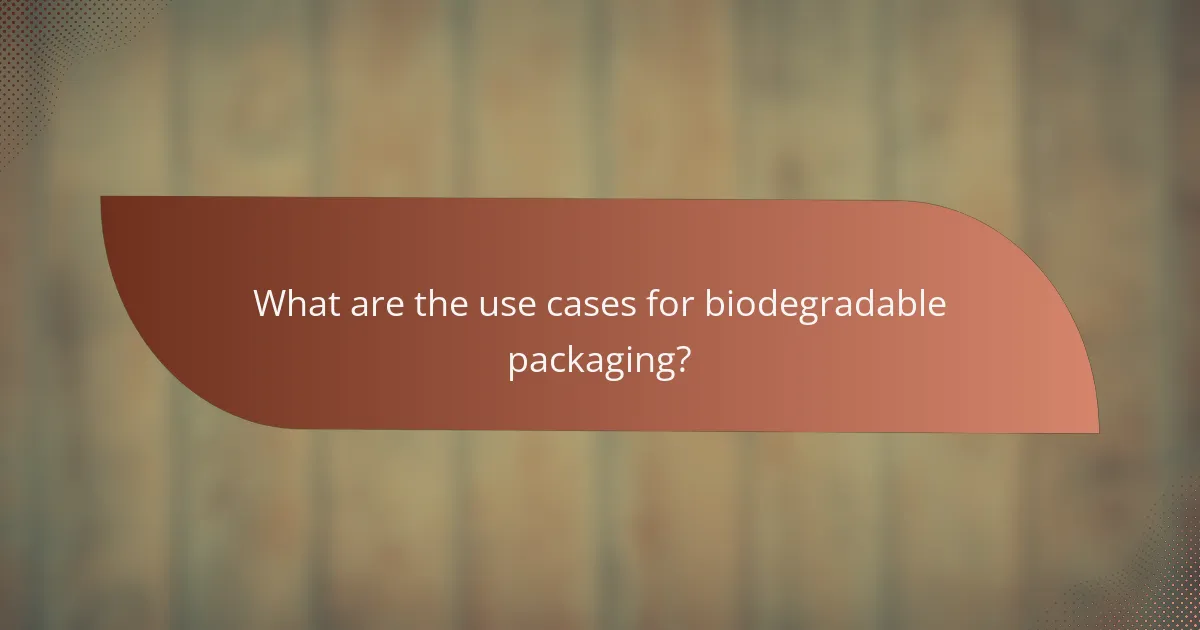In the ongoing quest for sustainable solutions, biodegradable and recyclable packaging emerge as two prominent options, each with distinct environmental benefits. Biodegradable packaging naturally decomposes, reducing landfill waste and pollution, while recyclable packaging promotes resource conservation and supports a circular economy. Understanding the unique advantages of each can help consumers and businesses make informed choices that align with their sustainability goals.

What are the benefits of biodegradable packaging?
Biodegradable packaging offers several advantages, primarily its ability to break down naturally, reducing environmental impact. It helps lessen landfill waste, minimizes pollution, supports sustainable practices, enhances brand image, and encourages consumer loyalty.
Reduces landfill waste
Biodegradable packaging decomposes more quickly than traditional materials, significantly reducing the volume of waste sent to landfills. This is crucial as landfills contribute to greenhouse gas emissions and take up valuable land resources. By opting for biodegradable options, businesses can help decrease the overall waste footprint.
For instance, products made from plant-based materials can break down in composting facilities within a few months, compared to plastic, which can take hundreds of years. This rapid decomposition aids in more efficient waste management.
Minimizes environmental pollution
Using biodegradable packaging helps reduce environmental pollution by decreasing the amount of plastic waste that ends up in oceans and natural habitats. This type of packaging breaks down into non-toxic components, preventing harmful substances from leaching into soil and waterways.
Moreover, biodegradable materials often require fewer chemicals during production, further lessening their environmental impact. This shift can lead to cleaner ecosystems and healthier wildlife.
Supports sustainable practices
Biodegradable packaging aligns with sustainable practices by promoting the use of renewable resources. Many biodegradable materials are derived from plants, which can be replenished, unlike fossil fuels used for conventional plastics.
Companies that adopt biodegradable packaging often find it easier to meet sustainability goals and comply with regulations aimed at reducing plastic waste, such as the European Union’s Single-Use Plastics Directive.
Enhances brand image
Utilizing biodegradable packaging can significantly enhance a brand’s image by showcasing a commitment to environmental responsibility. Consumers are increasingly drawn to brands that prioritize sustainability, and using eco-friendly packaging can differentiate a business in a crowded market.
Brands that communicate their use of biodegradable materials effectively can attract environmentally conscious customers, thereby increasing their market share and customer base.
Encourages consumer loyalty
When consumers see brands actively working to reduce their environmental impact through biodegradable packaging, they are more likely to develop loyalty to those brands. This loyalty stems from shared values regarding sustainability and a desire to support businesses that contribute positively to the planet.
Offering incentives, such as discounts for returning biodegradable packaging or participating in recycling programs, can further enhance consumer engagement and loyalty, creating a win-win situation for both the brand and its customers.

What are the benefits of recyclable packaging?
Recyclable packaging offers several key advantages, including resource conservation, energy savings, and support for a circular economy. By using materials that can be processed and reused, businesses and consumers can significantly reduce their environmental footprint.
Conserves natural resources
Recyclable packaging helps conserve natural resources by reducing the need for virgin materials. For instance, recycling paper can save trees, while recycling plastics decreases the demand for petroleum-based products. This conservation is vital for sustaining ecosystems and reducing habitat destruction.
By choosing recyclable options, companies can minimize their reliance on finite resources, which is increasingly important as global populations grow and consumption rises.
Reduces energy consumption
Using recyclable packaging typically requires less energy compared to producing new materials from scratch. For example, recycling aluminum saves about 90% of the energy needed to create new aluminum from bauxite ore. This energy efficiency translates into lower greenhouse gas emissions and a smaller carbon footprint.
Businesses can further enhance their sustainability efforts by optimizing their supply chains to incorporate recycled materials, thereby reducing overall energy use in production processes.
Promotes circular economy
Recyclable packaging is a cornerstone of the circular economy, which aims to keep materials in use for as long as possible. By recycling, products are reintroduced into the production cycle, minimizing waste and maximizing resource efficiency. This approach not only benefits the environment but also creates economic opportunities in recycling and manufacturing sectors.
Engaging in a circular economy can lead to innovative business models that prioritize sustainability, such as take-back programs and product-as-a-service offerings.
Facilitates waste management
Recyclable packaging simplifies waste management by providing clear pathways for disposal and processing. Many municipalities have established recycling programs that make it easy for consumers to sort and recycle materials. This reduces the volume of waste sent to landfills and promotes responsible disposal practices.
To maximize recycling rates, businesses should educate consumers about proper recycling practices and ensure their packaging is clearly labeled with recycling symbols. This can enhance participation in recycling initiatives and contribute to a cleaner environment.

How do biodegradable and recyclable packaging compare?
Biodegradable and recyclable packaging serve different environmental purposes and have unique benefits. Biodegradable packaging breaks down naturally over time, while recyclable packaging can be processed and reused to create new products, reducing waste and resource consumption.
Decomposition timeframes
Biodegradable packaging typically decomposes within a few months to a couple of years, depending on environmental conditions like temperature and moisture. In contrast, recyclable materials, such as plastics and metals, can persist in landfills for decades if not properly processed.
The speed of decomposition for biodegradable options can vary significantly based on the material type. For example, plant-based plastics may break down faster than traditional plastics, but still require specific composting conditions to do so effectively.
Material sourcing differences
Biodegradable packaging is often made from renewable resources such as corn starch, sugarcane, or other plant materials. This can reduce reliance on fossil fuels and lower carbon emissions associated with production.
Recyclable packaging, on the other hand, is typically derived from both renewable and non-renewable sources, including metals, glass, and certain plastics. The sourcing of these materials can have a significant impact on their overall environmental footprint, depending on extraction and manufacturing processes.
Cost implications
The cost of biodegradable packaging can be higher than traditional materials due to the sourcing and processing methods involved. Businesses may face increased expenses, which can be a barrier to widespread adoption.
Recyclable packaging often has a more established market, which can lead to lower costs, especially for materials like aluminum and paper. However, fluctuating market prices for recycled materials can affect overall costs, making budgeting challenging for companies.

What are the use cases for biodegradable packaging?
Biodegradable packaging is primarily used in industries where reducing environmental impact is essential. It is designed to break down naturally over time, making it suitable for applications that prioritize sustainability.
Food packaging solutions
Biodegradable packaging is increasingly popular in the food industry, where it can be used for items like takeout containers, wrappers, and bags. These materials often comply with food safety regulations, ensuring they are safe for direct contact with consumables. Common examples include plant-based plastics and compostable paper products, which can help reduce landfill waste.
Cosmetic product containers
In the cosmetic industry, biodegradable packaging is used for items such as creams, lotions, and makeup containers. Brands are opting for materials that decompose without leaving harmful residues, aligning with eco-conscious consumer preferences. For instance, biodegradable tubes and jars made from natural materials can enhance a brand’s sustainability profile while appealing to environmentally aware customers.
Single-use items
Single-use items like cutlery, plates, and straws are significant contributors to plastic waste. Biodegradable alternatives made from materials like cornstarch or sugarcane are gaining traction, especially in events and food service settings. These products typically break down within a few months under the right composting conditions, offering a practical solution for reducing single-use plastic pollution.
